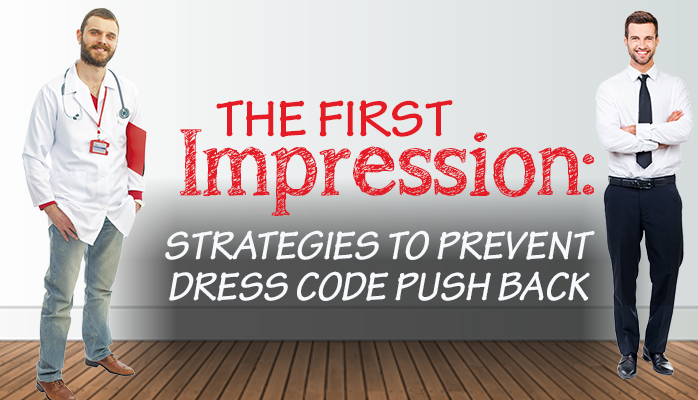If your organization’s current dress code is “business casual,” it may be that you’re not thrilled with what this actually looks like in your hospital or health care practice. Many human resource professionals have shared that dress code policy is one of their biggest challenges. During the hot summer months especially, I have observed that the casual look can sometimes drift toward carelessness.
Each of us has our personal style and fashion sense, and this is a great conversation starter on the subject of dress code. Rather than sending periodic reminders to employees about your organization’s dress code policy, it is imperative that your team leaders understand and communicate clearly to employees what the organization’s expectations are. They should emphasize that the dress code is not just some arbitrary set of guidelines from the administration, but that customers and patients form an opinion about their care based on first impressions. These impressions are strongly influenced by the demeanor and appearance of the employees they interact with in the organization.
Regardless of how experienced leaders are in their roles, when they have a disheveled appearance or arrive sporting clothes with hoods and drawstrings, you can be sure that team members will take this as an invitation to follow by example. This relaxed approach to work wear has certainly contributed to higher employee satisfaction, but on the flip side, a dressed down workforce can diminish patient confidence that they’ll receive the best care and service.
Begin by setting the example as a team leader and dress accordingly. Host open discussions about the importance of impressions, brand messaging, and image. As leaders, it is essential that you explain to all employees, physicians included, that attire and appearance (wrinkled scrubs and spotted lab coats too!) influence perception, and that each person working for the organization has the ability to instill confidence in patients and convey a positive feeling. A healthcare workplace isn’t the venue to express one’s individuality and creativity through their clothes. Remind employees that this is a professional standard you expect them to meet. Once you’ve established what the code is, communicate it clearly and make sure you reinforce it evenhandedly.
While many policies I’ve read offer a brief description of what constitutes appropriate casual attire, most don’t go far enough into detail and leave too much room for interpretation. Add to the ambiguity, “team/logo wear,” and you’ve muddied the already murky waters on the subject of what business casual attire means. Just because the organization’s name and logo appear on the t-shirt, doesn’t mean it’s appropriate to wear with a pair of scrubs to work. While this style is acceptable for the hospital softball game or fun run, it falls short of presenting a professional appearance when helping a patient.
Every administrator I’ve worked with over the past two decades wants to achieve the goal of being the healthcare organization that people trust and believe they will receive exceptional care and service from. Employee attire should reflect that intention. Here are a few suggestions for communicating with employees about dress code.
Communication Impactor!
Try developing periodic dress code features in your internal newsletter and display these with photos of do’s and don’ts (stock photos of course!)
Example: What to Wear? Tips to Instill Confidence in Our Care and Service!
- Don’t push the envelope. If you have to ask, “Will I get away with this?” Best to have a second clothing option in mind.
- While the pockets do come in handy, cargo pants are not business casual.
- If “Spandex” is on the label and it is meant to wear as an outer garment, pass.
- If it’s too tight, too short or revealing too much, it does not meet the casual business criteria.
Finally, keep in mind that image and appearance is not only a patient perception matter. The adage, “You only have one chance to make a first impression, make it a good one,” is especially relevant to those entering the healthcare profession. New employees are as important as new patients. It begins at orientation. I am a huge proponent for setting the tone right off the bat. Of course, you want staff to be comfortable on ‘class room days’, but let’s be honest, there are plenty of options other than athletic pants and flannel shirts. There is no better time to reinforce your dress standards than on day one of an employee’s new job.
Please consider following me on Twitter @MRBImpact







